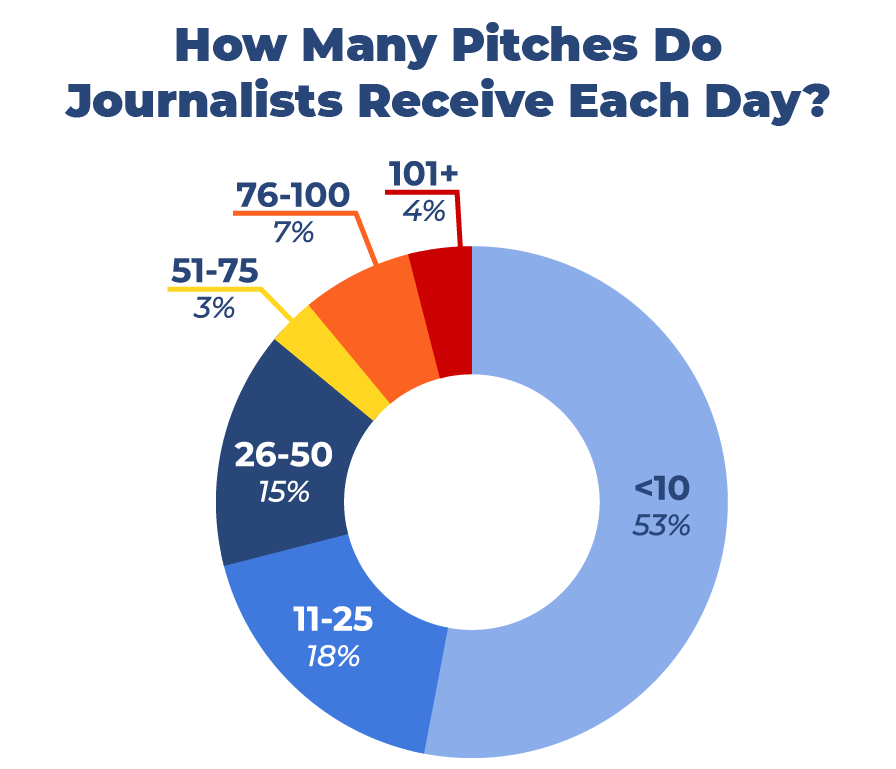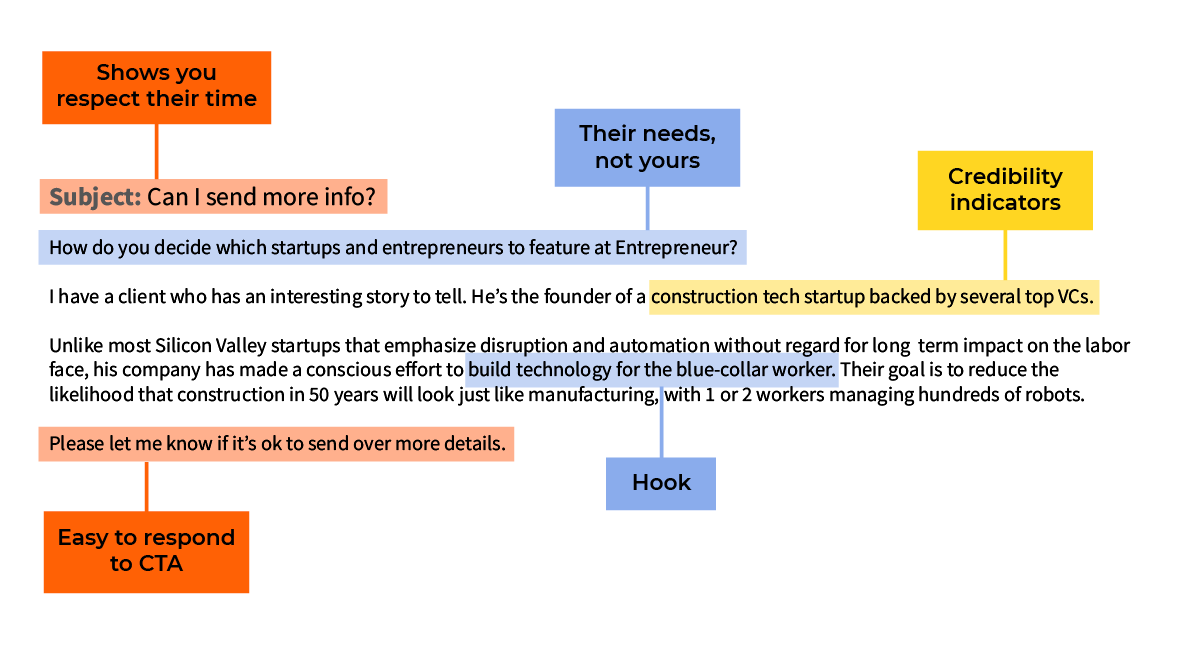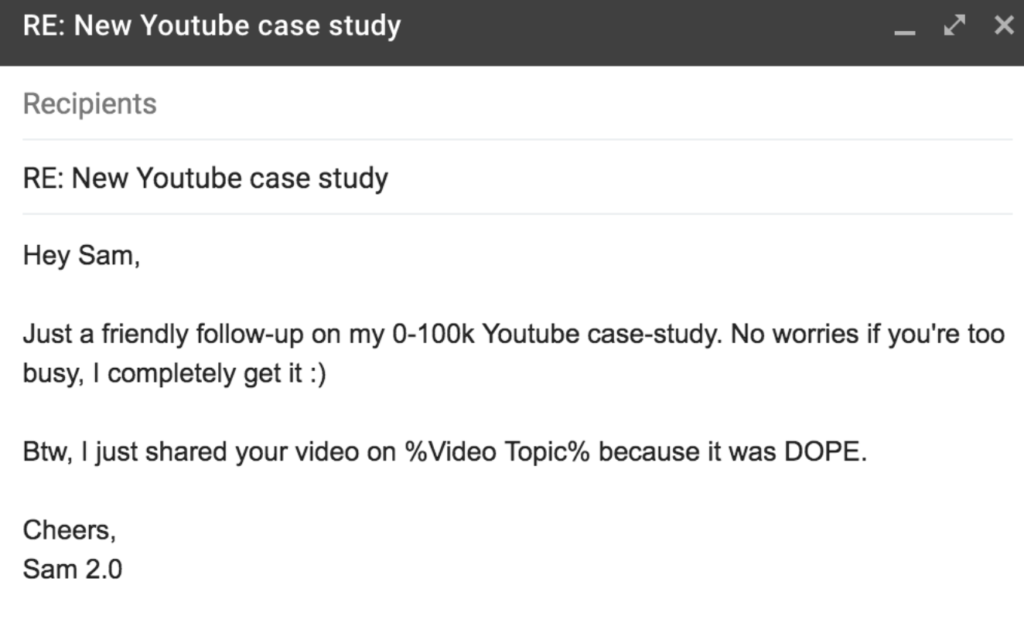Do you wish the press would cover your company? Getting featured by major news publications can be a huge boon, not only boosting your brand’s credibility but also helping grow your web traffic.
Let’s face it: reaching out to the press can be intimidating. You may not know what to write or even who to contact. But crafting the right story can mean the difference between getting your brand featured in TechCrunch, Entrepreneur, or Forbes, or going unnoticed.
Pitching the media requires persuasion, creativity, and the ability to connect with others. Therefore, it’s important to understand the perspective of journalists when determining how to write a pitch. So what does it look like from the other side?
According to one survey, 70% of journalists write only one story per day. However, they get pitched many more topics. In fact, 47% of writers get pitched more than 10 times per day, 14% of writers get 50+ pitchers per day, and 4% get pitched more than 100 times per day. This equates to roughly 50-500 pitches per week for only 5 articles. Demand far outweighs supply.

U.S. Census data on PR professionals shows they exceeded the number of reporters by more than six-to-one in 2018. No wonder it’s so hard to cut through the noise! Some journalists from The New York Times, Fortune Magazine, and The Associated Press have even taken to Twitter to complain about the number of irrelevant and poorly worded pitches they receive.
A reminder to anyone trying to pitch me. I don't cover 99% of the topics you send: CBD, cannabis, parenting, beauty, etc. It's a simple and basic courtesy to **read my work** before tossing some more useless word salad at me. That's why I have a website.#PRFail #publicrelations
— Caitlin Kelly (@CaitlinKellyNYC) June 11, 2019
Once in a while, a PR at an agency will ask me why reporters ignore so many of pitches. Here's one reason: so many times when I decline a pitch, I soon get a follow up as if I had never answered them. So why bother answering if a PR will ignore it or not keep track? #prfail
— Phil Wahba (@philwahba) March 8, 2019
when will PR peeps learn not to use templates? "dear first name" and "..would make a great story for NBC" or "…XXX magazine" are not helping your pitches. #prfail
— Marilynn Marchione (@MMarchioneAP) June 4, 2019
Why Outreach Matters
Earning quality links is a critical part of SEO. It’s one of the most heavily weighted factors that Google uses in its algorithm to rank search results. But there are other benefits that come with press and backlinks as well. It can bring awareness to your brand as a thought leader. In addition, the more exposure your company gets in the media, the easier it becomes to recruit talented employees to join your team or raise capital from investors.
How to Write a Persuasive Journalist Pitch
A persuasive pitch email will vary depending on the story being suggested and the journalist you’re targeting. However, there are different strategies you can use to help pitch journalists effectively.
In general, writing short paragraphs is a good idea. It makes it easier for journalists to skim through your message and locate the important details. They don’t have time to read a lengthy email, so cut the fluff and be concise.
While it can be tempting to give away the whole story, craft a PR hook that includes just enough information to pique the reader’s curiosity and outline an easy next step that requires minimal effort to respond to. In a nutshell, make it easy for the journalist or blogger to opt into the conversation.
Finally, a lot of PR specialists struggle with developing the correct tone in their pitches. If you use too formal a tone then you risk coming across as robotic or inauthentic. On the other hand, if you use language that is too casual, then you may appear unprofessional. The best PR pitches strike the right balance.
PRO TIP: Pretend like you are writing to an old friend. If you can get into this mindset, then your message will be more likely to walk the line between a friendly, yet deferential tone.
Now let’s break down the process for how to pitch journalists into three easy steps to see what this looks like in practice.
Step 1: Develop Your Journalist Pitch Hook
What is a PR hook? It’s a way of presenting your information or story in order to pique interest. Your hook is one of the most important parts of getting the attention of journalists and bloggers. It should be:
- Unique
- Unexpected (not too obvious)
- Helpful to the person you are contacting
- Easy to understand
There are a variety of different hooks you can use in your pitches. For example, entrepreneur interview profiles can work well if the CEO or founder has an interesting background. Piggybacking a news story can allow a company to get publicity by adding value to a larger original story. In addition, important company announcements such as startup fundraising rounds or new product launches are opportunities to connect with reporters who want to break the story.
Step 2: Establish Credibility
Establishing credibility comes down to answering one question: Why should the reader listen to you?
It’s important to demonstrate your expertise because journalists want to cite reliable sources. You can do this by highlighting impressive facts about your company such as fundraising efforts, revenue figures, enterprise customers, awards, or even the number of years in business.
Bottom line: you want to include accurate information that encourages journalists to trust your story.
Step 3: Include a Clear Call-to-Action
At the end of your pitch, create a clear call to action. You want to make it easy for the other person to reply. Examples might include:
- Can I send more information?
- Would your readers be interested in learning more?
- Can I connect you with our CEO for more details?
Remember, you are offering value for them to pass on to their readers. Your initial goal is to develop rapport and get the other person to write back.
A Strong Journalist Pitch Email Example
So what does this actually look like? Here’s an example of a pitch sequence our team sent for Fieldwire, a B2B construction software company.
1. Initial pitch to pique interest

2. The journalist replies and wants to learn more
Sure — What is the company? Are they using the technology now?
3. A strong follow-up to seal the deal

This pitch angle was able to garner press coverage and links on a number of construction trade publications and business outlets. Here are some examples:
Target the Right Contacts
It doesn’t matter how good your pitch is if it doesn’t get seen by the right people. Most PR and SEO agencies use mass sending tools. Unfortunately, this high-volume approach usually yields marginal results over the long term. Instead, a better strategy is to develop a system for targeting and keeping track of who you’ve reached out to. This means researching editors, reporters, and bloggers that you think would be a good fit to cover your story.
It doesn’t have to be complicated. Google, Twitter, and LinkedIn are good places to start searching. Since journalists frequently change jobs or switch beats, it’s best to review some of the recent articles they have published so you can make sure they are the right person to contact. Just because they wrote an article last year about a relevant topic doesn’t mean that’s still what they’re working on.
One of the most tedious parts of prospecting is finding up-to-date contact information for journalists. Sometimes this information can be found on publishers’ websites. Sometimes journalists will list their email addresses in their author bio or Twitter profile. But sometimes it can be hard to locate. If your pitch emails are frequently bouncing, then you’re losing valuable time. The last thing you want is to send bounced emails. Fortunately, there are online tools such as Clearbit, Respona, Hunter, Norbert, and RocketReach that can help you quickly find the contact information you need to start pitching. If you’re unable to find an email address with these resources, then it’s often a sign the person no longer works for the publication or they don’t accept unsolicited pitches.
Relationship Building 101
Relationships matter, even those that exist online. Your goal should be to develop mutually beneficial relationships with journalists, not immediately landing coverage in their publication. So, how do you approach a journalist? Think of pitching the press like attending a cocktail party. You wouldn’t walk up to someone you have never met and ask them to date you. Journalists are more likely to respond to messages from individuals they know or names they recognize.
How you go about relationship building will depend on the person you’re contacting. For example, journalists from top publications like the New York Times and Wall Street Journal are busy and only interested in the most newsworthy stories. So be succinct when communicating with them. Smaller bloggers, on the other hand, may appreciate more personal attention and acknowledgment of their work. You may want to invest more time into developing rapport by commenting on their articles and connecting on social media, for example.
Inc. Magazine writer and LinkedIn influencer, Jeff Haden, recommends creating value for the other person in order to develop win-win relationships. Here is his advice on how to become a contributor to tier 1 business publications.

“The key is to prove that you have something to say, can say it well, know how to attract an audience, and hopefully have an audience already. In short, why you. And show that you don’t just see it as a promotional tool but that you have useful, practical, informative, etc stuff to say. Every outlet wants to know how you will help them, not how publishing on their site will help you. Too many potential contributors focus on the ‘wow this would be such a great opportunity for me’ angle.”
The Art of the Follow-up
Don’t give up if you don’t get a response the first time. Quality pitches can get overlooked, especially since journalists receive tons of subpar outreach every day. It’s usually a good idea to send one follow-up. While it may be tempting to send a canned message like “Hey, following up on this, thanks!”, it’s unlikely to capture the attention of a seasoned journalist. You run the risk of annoying the other person and getting flagged as spam. Instead, try offering more value with your follow-up.
Here’s an example of an effective follow-up pitch from Sam Oh at Ahrefs:

No one likes getting bombarded with multiple emails about the same request. If you follow-up too much, you may burn a bridge that could have eventually developed into a productive long-term relationship. In the PR world, relationships are more valuable than any one-off pitch.
3 Mistakes to Avoid When Pitching Journalists
While there is no single way to pitch journalists, there are mistakes that even the most experienced marketers and PR professionals make. Here are some of the common errors to avoid:
- Don’t use generic template messages. No one likes to receive an email that was blasted out to the masses. Take your time to research the writer and personalize your message. Yes, this requires more work, but your response rates will be much higher.
- Avoid pushy language or demanding a backlink. This is a big turn-off for most journalists and influencers. It’s one of the reasons many marketers struggle with link building. They come across as desperate and too focused on their own needs, which prevents trust and rapport from ever taking place.
- Skip the fake flattery. Don’t compliment people unless you mean it. Genuinely compliment their work because you found it helpful or interesting, not because you think that’s what they want to hear. It’s easy to tell when someone is being insincere. Always remember that there’s a real person on the other side of your monitor.
Fostering the Right Mindset
Ultimately, not every writer will reply to your pitch. Rejection hurts. But that’s part of the game. It’s important to develop the right mindset and embrace the challenge.
The Hall of Fame baseball player, Ted Williams, once said:

“Baseball is the only field of endeavor where a man can succeed three out of ten times and be considered a good performer.”
If Ted Williams was alive today, he might want to reword his quote to also include public relations professionals and SEOs. No one lands every story. So keep iterating your approach based on the feedback you receive.
CanIRank’s Approach to Digital PR
Whether it’s social shares, links, or media mentions, PR is a critical part of succeeding online. Earning press coverage is hard, but that’s also what makes it so valuable.
If you are an in-house marketer, then CanIRank’s software can help with improving efficiency. The Promote My Content tool analyzes thousands of press opportunities that offer the best balance between fit for your business, pitch acceptance rate, and authority.
Or if you want to partner with an agency, then our team of digital PR specialists can help your business generate brand awareness. We understand how PR can support marketing goals by driving additional traffic and sales. Our software combined with a team experienced in building relationships and pitching journalists helps us achieve a much better ROI than an old-school PR agency.
But don’t take our word for it. Here are examples of responses our team has received from top publishers.
“I very much would like to hear about your findings. If you have an embargoed draft of the report, perhaps I could write a piece about it”

“Thanks so much! I think this will come in handy for a package we’re putting together. I’ll be in touch if we need anything else!”

“I’d love to publish this and send to partners. Please send an exclusive quote for the report.”

“This is good and a lot different than most of what we get, yet apropos nonetheless…watch for a contributor agreement coming.”

To learn more about CanIRank’s digital PR services, schedule a free consultation or check out our case studies to see samples of our work.







Leave A Comment